navigation SKODA OCTAVIA 2013 3.G / (5E) Columbus Navigation System Manual
[x] Cancel search | Manufacturer: SKODA, Model Year: 2013, Model line: OCTAVIA, Model: SKODA OCTAVIA 2013 3.G / (5E)Pages: 90, PDF Size: 5.21 MB
Page 59 of 90
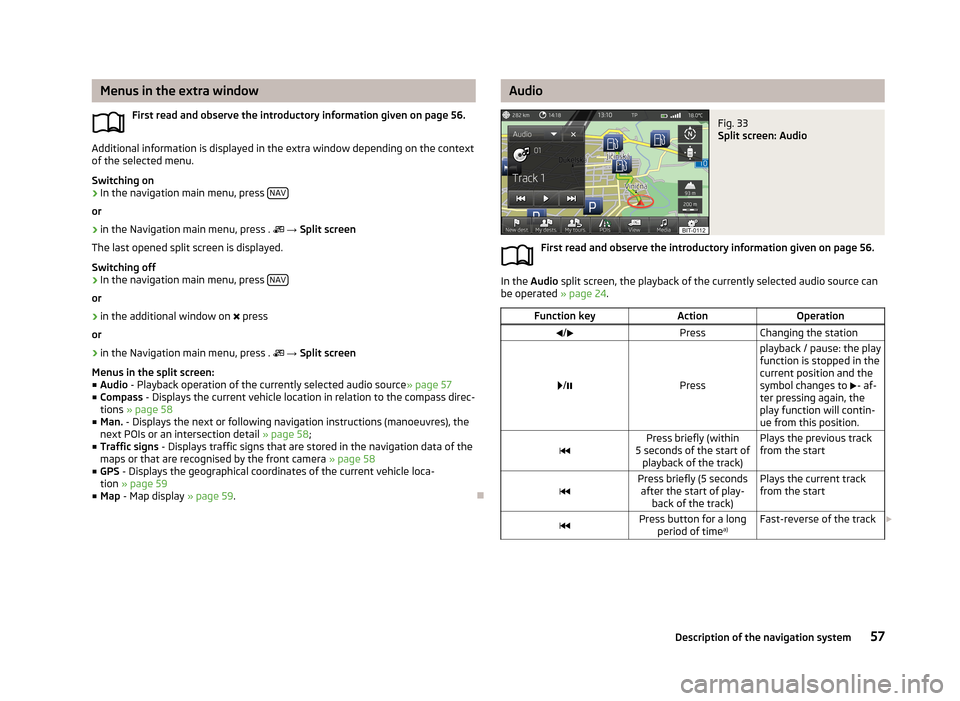
Menus in the extra windowFirst read and observe the introductory information given on page 56.
Additional information is displayed in the extra window depending on the context
of the selected menu.
Switching on
›
In the navigation main menu, press NAV
or
›
in the Navigation main menu, press .
→ Split screen
The last opened split screen is displayed.
Switching off
›
In the navigation main menu, press NAV
or
›
in the additional window on
press
or
›
in the Navigation main menu, press .
→ Split screen
Menus in the split screen:
■ Audio - Playback operation of the currently selected audio source » page 57
■ Compass - Displays the current vehicle location in relation to the compass direc-
tions » page 58
■ Man. - Displays the next or following navigation instructions (manoeuvres), the
next POIs or an intersection detail » page 58;
■ Traffic signs - Displays traffic signs that are stored in the navigation data of the
maps or that are recognised by the front camera » page 58
■ GPS - Displays the geographical coordinates of the current vehicle loca-
tion » page 59
■ Map - Map display » page 59.
AudioFig. 33
Split screen: Audio
First read and observe the introductory information given on page 56.
In the Audio split screen, the playback of the currently selected audio source can
be operated » page 24.
Function keyActionOperation/PressChanging the station
/Press
playback / pause: the play
function is stopped in the
current position and the
symbol changes to - af-
ter pressing again, the
play function will contin-
ue from this position.Press briefly (within
5 seconds of the start of playback of the track)Plays the previous track
from the startPress briefly (5 seconds after the start of play- back of the track)Plays the current track
from the startPress button for a long period of time a)Fast-reverse of the track
57Description of the navigation system
Page 60 of 90
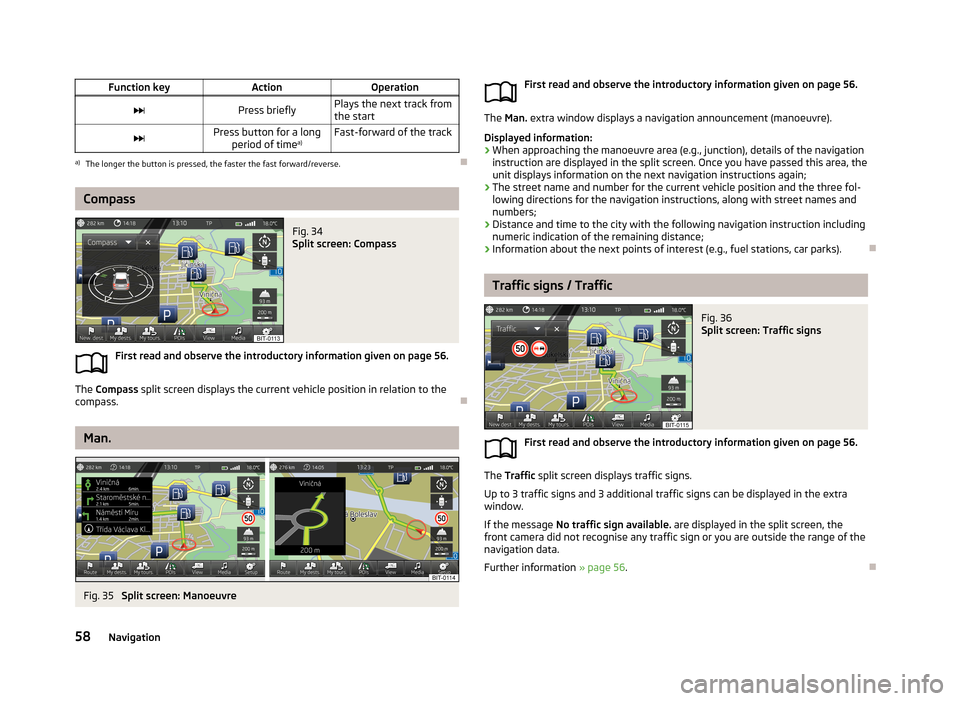
Function keyActionOperationPress brieflyPlays the next track from
the startPress button for a long period of time a)Fast-forward of the tracka)
The longer the button is pressed, the faster the fast forward/reverse.
Compass
Fig. 34
Split screen: Compass
First read and observe the introductory information given on page 56.
The
Compass split screen displays the current vehicle position in relation to the
compass.
Man.
Fig. 35
Split screen: Manoeuvre
First read and observe the introductory information given on page 56.
The Man. extra window displays a navigation announcement (manoeuvre).
Displayed information: › When approaching the manoeuvre area (e.g., junction), details of the navigation
instruction are displayed in the split screen. Once you have passed this area, the
unit displays information on the next navigation instructions again;
› The street name and number for the current vehicle position and the three fol-
lowing directions for the navigation instructions, along with street names and numbers;
› Distance and time to the city with the following navigation instruction including
numeric indication of the remaining distance;
› Information about the next points of interest (e.g., fuel stations, car parks).
Traffic signs / Traffic
Fig. 36
Split screen: Traffic signs
First read and observe the introductory information given on page 56.
The
Traffic split screen displays traffic signs.
Up to 3 traffic signs and 3 additional traffic signs can be displayed in the extra window.
If the message No traffic sign available. are displayed in the split screen, the
front camera did not recognise any traffic sign or you are outside the range of the
navigation data.
Further information » page 56.
58Navigation
Page 61 of 90
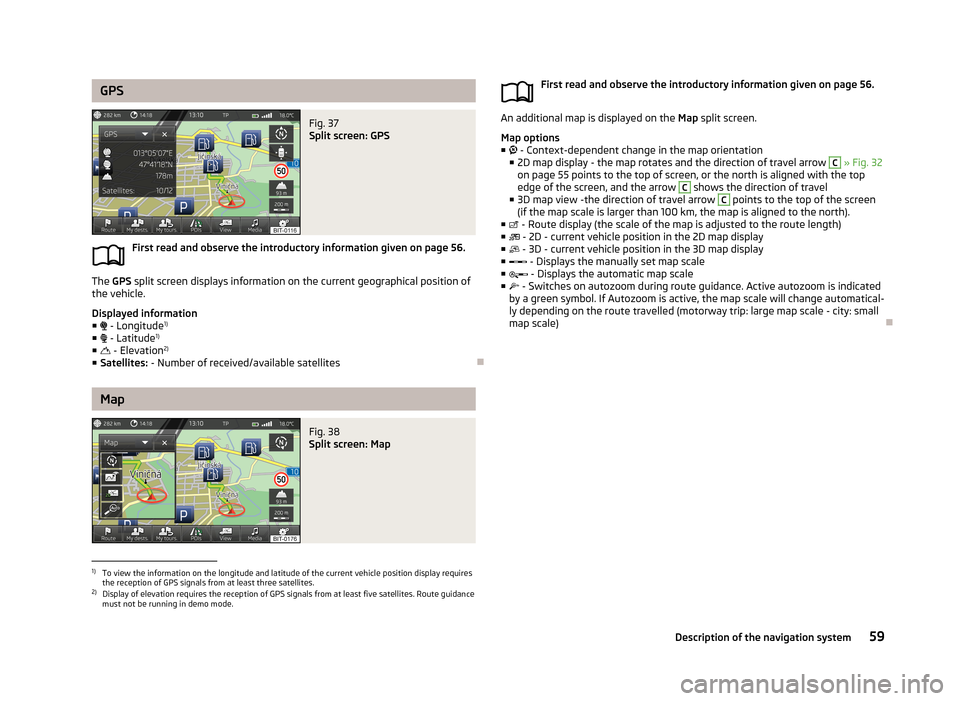
GPSFig. 37
Split screen: GPS
First read and observe the introductory information given on page 56.
The GPS split screen displays information on the current geographical position of
the vehicle.
Displayed information
■ - Longitude 1)
■ - Latitude 1)
■ - Elevation 2)
■ Satellites: - Number of received/available satellites
Map
Fig. 38
Split screen: MapFirst read and observe the introductory information given on page 56.
An additional map is displayed on the Map split screen.
Map options
■ - Context-dependent change in the map orientation
■ 2D map display - the map rotates and the direction of travel arrow
C
» Fig. 32
on page 55 points to the top of screen, or the north is aligned with the top
edge of the screen, and the arrow
C
shows the direction of travel
■ 3D map view -the direction of travel arrow
C
points to the top of the screen
(if the map scale is larger than 100 km, the map is aligned to the north).
■ - Route display (the scale of the map is adjusted to the route length)
■ - 2D - current vehicle position in the 2D map display
■ - 3D - current vehicle position in the 3D map display
■ - Displays the manually set map scale
■ - Displays the automatic map scale
■ - Switches on autozoom during route guidance. Active autozoom is indicated
by a green symbol. If Autozoom is active, the map scale will change automatical-
ly depending on the route travelled (motorway trip: large map scale - city: small
map scale)
1)
To view the information on the longitude and latitude of the current vehicle position display requires
the reception of GPS signals from at least three satellites.
2)
Display of elevation requires the reception of GPS signals from at least five satellites. Route guidance must not be running in demo mode.
59Description of the navigation system
Page 62 of 90
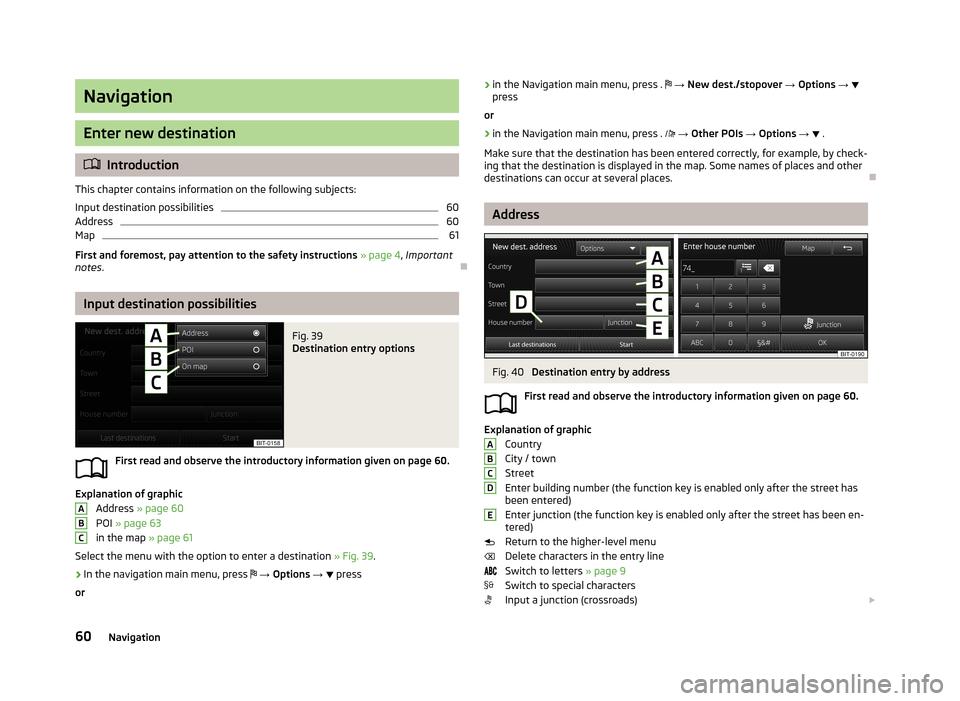
Navigation
Enter new destination
Introduction
This chapter contains information on the following subjects:
Input destination possibilities
60
Address
60
Map
61
First and foremost, pay attention to the safety instructions » page 4 , Important
notes .
Input destination possibilities
Fig. 39
Destination entry options
First read and observe the introductory information given on page 60.
Explanation of graphic
Address » page 60
POI » page 63
in the map » page 61
Select the menu with the option to enter a destination » Fig. 39.
›
In the navigation main menu, press
→ Options →
press
or
ABC› in the Navigation main menu, press .
→ New dest./stopover → Options →
press
or›
in the Navigation main menu, press .
→ Other POIs → Options → .
Make sure that the destination has been entered correctly, for example, by check-
ing that the destination is displayed in the map. Some names of places and other
destinations can occur at several places.
Address
Fig. 40
Destination entry by address
First read and observe the introductory information given on page 60.
Explanation of graphic Country
City / town
Street
Enter building number (the function key is enabled only after the street has
been entered)
Enter junction (the function key is enabled only after the street has been en-
tered)
Return to the higher-level menu
Delete characters in the entry line
Switch to letters » page 9
Switch to special characters
Input a junction (crossroads)
ABCDE60Navigation
Page 63 of 90
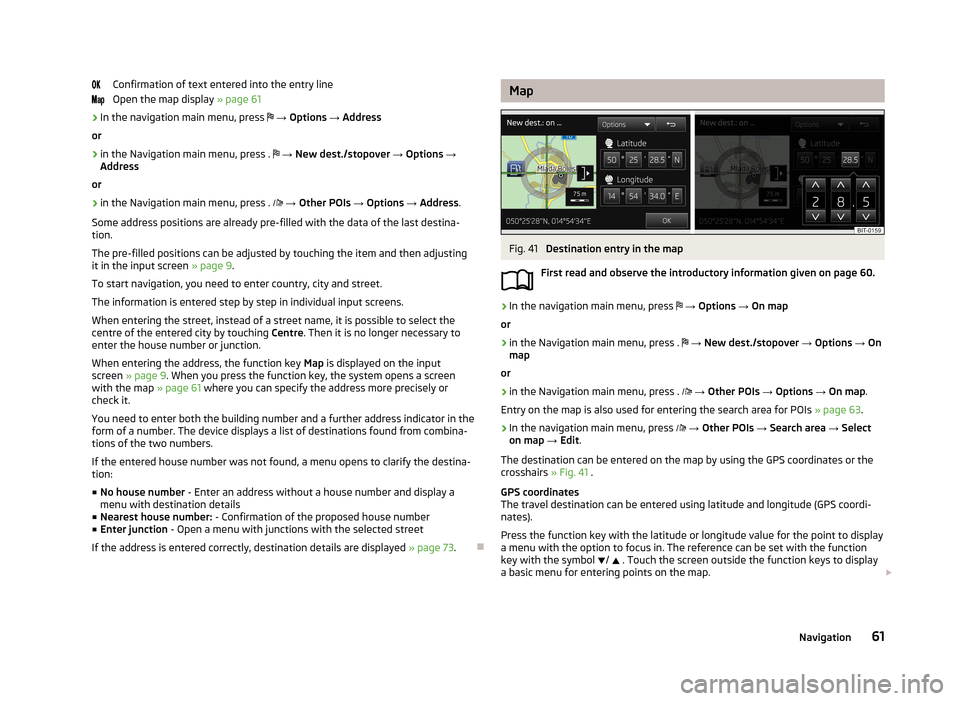
Confirmation of text entered into the entry lineOpen the map display » page 61›
In the navigation main menu, press
→ Options → Address
or
›
in the Navigation main menu, press .
→ New dest./stopover → Options →
Address
or
›
in the Navigation main menu, press .
→ Other POIs → Options → Address .
Some address positions are already pre-filled with the data of the last destina-
tion.
The pre-filled positions can be adjusted by touching the item and then adjusting
it in the input screen » page 9.
To start navigation, you need to enter country, city and street.
The information is entered step by step in individual input screens.
When entering the street, instead of a street name, it is possible to select thecentre of the entered city by touching Centre. Then it is no longer necessary to
enter the house number or junction.
When entering the address, the function key Map is displayed on the input
screen » page 9 . When you press the function key, the system opens a screen
with the map » page 61 where you can specify the address more precisely or
check it.
You need to enter both the building number and a further address indicator in the form of a number. The device displays a list of destinations found from combina-
tions of the two numbers.
If the entered house number was not found, a menu opens to clarify the destina-
tion:
■ No house number - Enter an address without a house number and display a
menu with destination details
■ Nearest house number: - Confirmation of the proposed house number
■ Enter junction - Open a menu with junctions with the selected street
If the address is entered correctly, destination details are displayed » page 73.
MapFig. 41
Destination entry in the map
First read and observe the introductory information given on page 60.
›
In the navigation main menu, press
→ Options → On map
or
›
in the Navigation main menu, press .
→ New dest./stopover → Options → On
map
or
›
in the Navigation main menu, press .
→ Other POIs → Options → On map .
Entry on the map is also used for entering the search area for POIs » page 63.
›
In the navigation main menu, press
→ Other POIs → Search area → Select
on map → Edit .
The destination can be entered on the map by using the GPS coordinates or the crosshairs » Fig. 41 .
GPS coordinates
The travel destination can be entered using latitude and longitude (GPS coordi-
nates).
Press the function key with the latitude or longitude value for the point to display a menu with the option to focus in. The reference can be set with the function
key with the symbol
/
. Touch the screen outside the function keys to display
a basic menu for entering points on the map.
61Navigation
Page 64 of 90
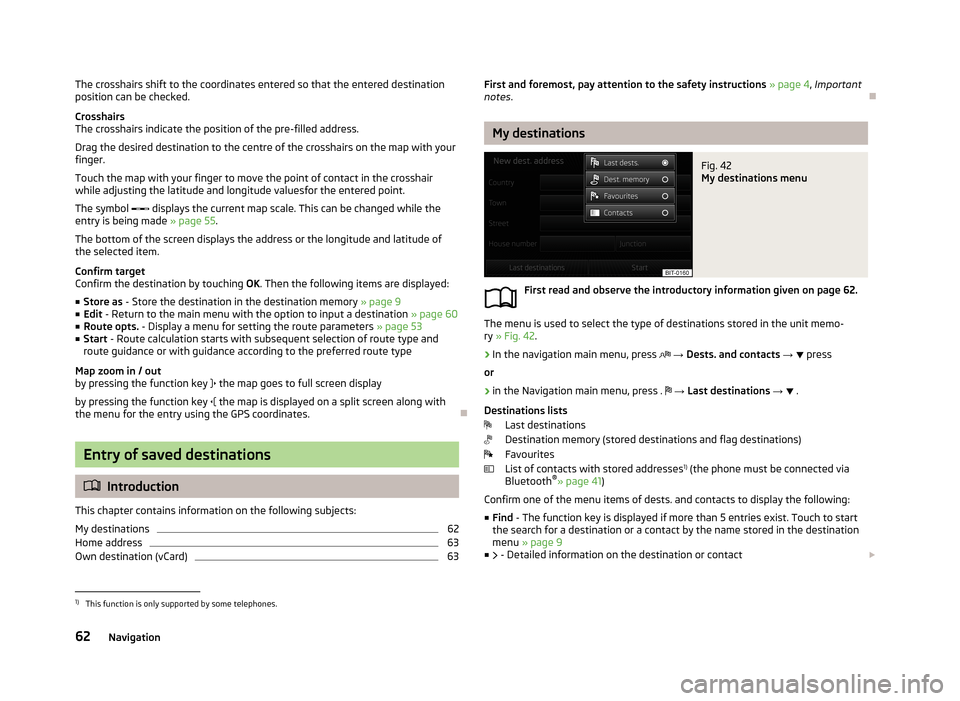
The crosshairs shift to the coordinates entered so that the entered destination
position can be checked.
Crosshairs
The crosshairs indicate the position of the pre-filled address.
Drag the desired destination to the centre of the crosshairs on the map with your
finger.
Touch the map with your finger to move the point of contact in the crosshair
while adjusting the latitude and longitude valuesfor the entered point.
The symbol displays the current map scale. This can be changed while the
entry is being made » page 55.
The bottom of the screen displays the address or the longitude and latitude of
the selected item.
Confirm target
Confirm the destination by touching OK. Then the following items are displayed:
■ Store as - Store the destination in the destination memory » page 9
■ Edit - Return to the main menu with the option to input a destination » page 60
■ Route opts. - Display a menu for setting the route parameters » page 53
■ Start - Route calculation starts with subsequent selection of route type and
route guidance or with guidance according to the preferred route type
Map zoom in / out
by pressing the function key
the map goes to full screen display
by pressing the function key
the map is displayed on a split screen along with
the menu for the entry using the GPS coordinates.
Entry of saved destinations
Introduction
This chapter contains information on the following subjects:
My destinations
62
Home address
63
Own destination (vCard)
63First and foremost, pay attention to the safety instructions » page 4 , Important
notes .
My destinations
Fig. 42
My destinations menu
First read and observe the introductory information given on page 62.
The menu is used to select the type of destinations stored in the unit memo-
ry » Fig. 42 .
›
In the navigation main menu, press
→ Dests. and contacts →
press
or
›
in the Navigation main menu, press .
→ Last destinations →
.
Destinations lists Last destinations
Destination memory (stored destinations and flag destinations)
Favourites
List of contacts with stored addresses 1)
(the phone must be connected via
Bluetooth ®
» page 41 )
Confirm one of the menu items of dests. and contacts to display the following: ■ Find - The function key is displayed if more than 5 entries exist. Touch to start
the search for a destination or a contact by the name stored in the destination
menu » page 9
■ - Detailed information on the destination or contact
1)
This function is only supported by some telephones.
62Navigation
Page 65 of 90
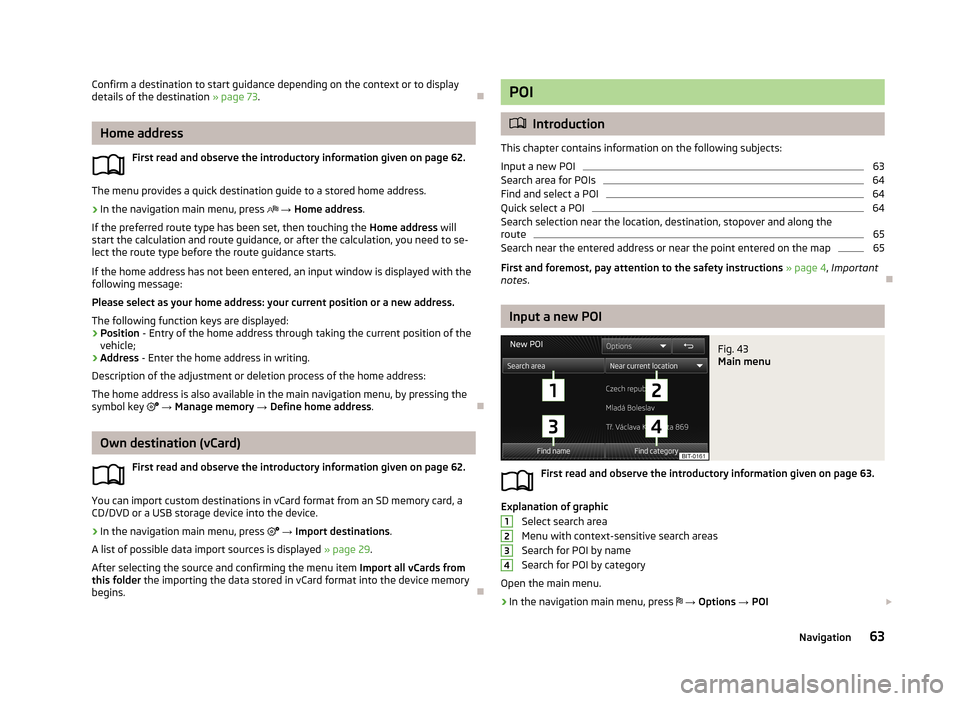
Confirm a destination to start guidance depending on the context or to display
details of the destination » page 73.
Home address
First read and observe the introductory information given on page 62.
The menu provides a quick destination guide to a stored home address.
›
In the navigation main menu, press
→ Home address .
If the preferred route type has been set, then touching the Home address will
start the calculation and route guidance, or after the calculation, you need to se-
lect the route type before the route guidance starts.
If the home address has not been entered, an input window is displayed with the following message:
Please select as your home address: your current position or a new address.
The following function keys are displayed:
› Position
- Entry of the home address through taking the current position of the
vehicle;
› Address
- Enter the home address in writing.
Description of the adjustment or deletion process of the home address:
The home address is also available in the main navigation menu, by pressing the
symbol key
→ Manage memory → Define home address .
Own destination (vCard)
First read and observe the introductory information given on page 62.
You can import custom destinations in vCard format from an SD memory card, a
CD/DVD or a USB storage device into the device.
›
In the navigation main menu, press
→ Import destinations .
A list of possible data import sources is displayed » page 29.
After selecting the source and confirming the menu item Import all vCards from
this folder the importing the data stored in vCard format into the device memory
begins.
POI
Introduction
This chapter contains information on the following subjects: Input a new POI
63
Search area for POIs
64
Find and select a POI
64
Quick select a POI
64
Search selection near the location, destination, stopover and along the
route
65
Search near the entered address or near the point entered on the map
65
First and foremost, pay attention to the safety instructions » page 4 , Important
notes .
Input a new POI
Fig. 43
Main menu
First read and observe the introductory information given on page 63.
Explanation of graphic
Select search area
Menu with context-sensitive search areas
Search for POI by name
Search for POI by category
Open the main menu.
›
In the navigation main menu, press
→ Options → POI
123463Navigation
Page 66 of 90
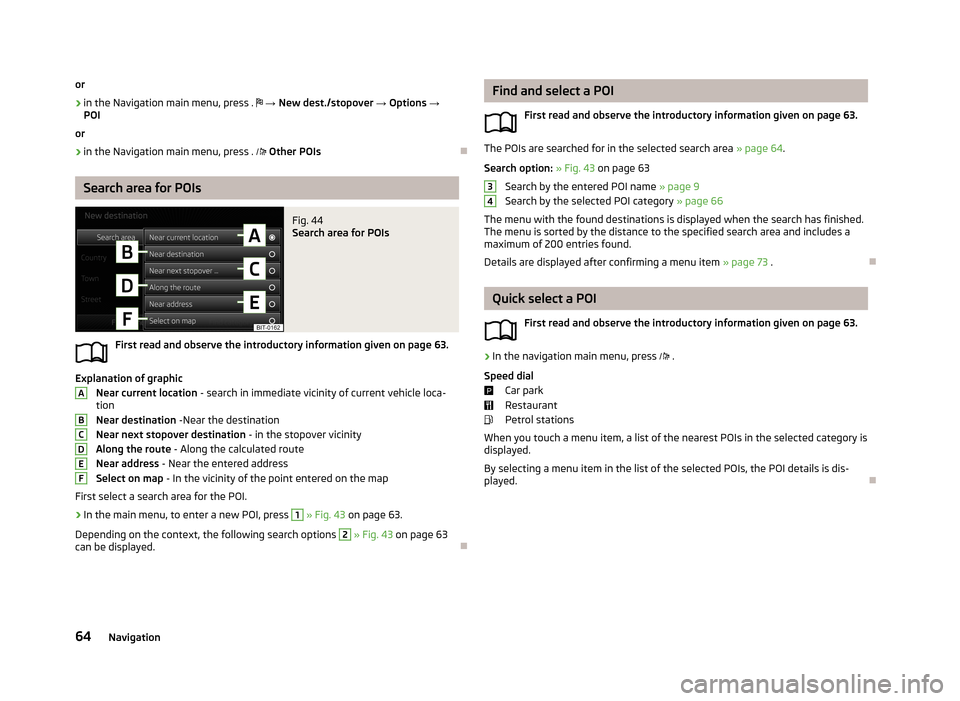
or›
in the Navigation main menu, press .
→ New dest./stopover → Options →
POI
or
›
in the Navigation main menu, press .
Other POIs
Search area for POIs
Fig. 44
Search area for POIs
First read and observe the introductory information given on page 63.
Explanation of graphic
Near current location - search in immediate vicinity of current vehicle loca-
tion
Near destination -Near the destination
Near next stopover destination - in the stopover vicinity
Along the route - Along the calculated route
Near address - Near the entered address
Select on map - In the vicinity of the point entered on the map
First select a search area for the POI.
›
In the main menu, to enter a new POI, press
1
» Fig. 43 on page 63.
Depending on the context, the following search options
2
» Fig. 43 on page 63
can be displayed.
ABCDEFFind and select a POI
First read and observe the introductory information given on page 63.
The POIs are searched for in the selected search area » page 64.
Search option: » Fig. 43 on page 63
Search by the entered POI name » page 9
Search by the selected POI category » page 66
The menu with the found destinations is displayed when the search has finished. The menu is sorted by the distance to the specified search area and includes a
maximum of 200 entries found.
Details are displayed after confirming a menu item » page 73 .
Quick select a POI
First read and observe the introductory information given on page 63.
›
In the navigation main menu, press .
Speed dial Car park
Restaurant
Petrol stations
When you touch a menu item, a list of the nearest POIs in the selected category is
displayed.
By selecting a menu item in the list of the selected POIs, the POI details is dis-
played.
3464Navigation
Page 67 of 90
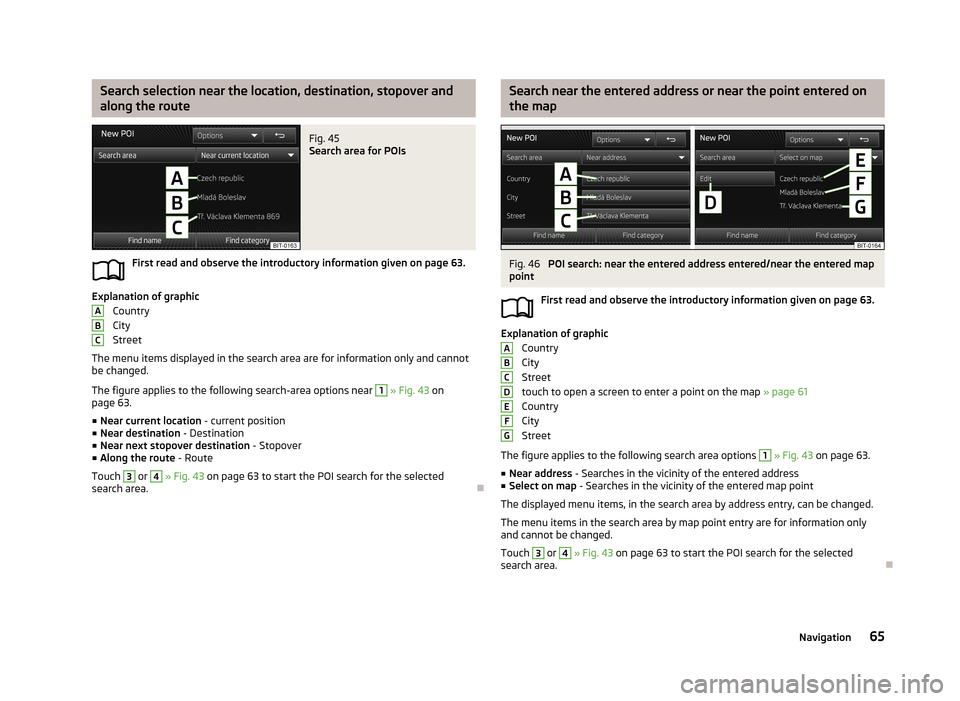
Search selection near the location, destination, stopover and
along the routeFig. 45
Search area for POIs
First read and observe the introductory information given on page 63.
Explanation of graphic Country
City
Street
The menu items displayed in the search area are for information only and cannot
be changed.
The figure applies to the following search-area options near
1
» Fig. 43 on
page 63.
■ Near current location - current position
■ Near destination - Destination
■ Near next stopover destination - Stopover
■ Along the route - Route
Touch
3
or
4
» Fig. 43 on page 63 to start the POI search for the selected
search area.
ABCSearch near the entered address or near the point entered on
the mapFig. 46
POI search: near the entered address entered/near the entered map
point
First read and observe the introductory information given on page 63.
Explanation of graphicCountry
City
Street
touch to open a screen to enter a point on the map » page 61
Country
City
Street
The figure applies to the following search area options
1
» Fig. 43 on page 63.
■ Near address - Searches in the vicinity of the entered address
■ Select on map - Searches in the vicinity of the entered map point
The displayed menu items, in the search area by address entry, can be changed. The menu items in the search area by map point entry are for information only
and cannot be changed.
Touch
3
or
4
» Fig. 43 on page 63 to start the POI search for the selected
search area.
ABCDEFG65Navigation
Page 68 of 90
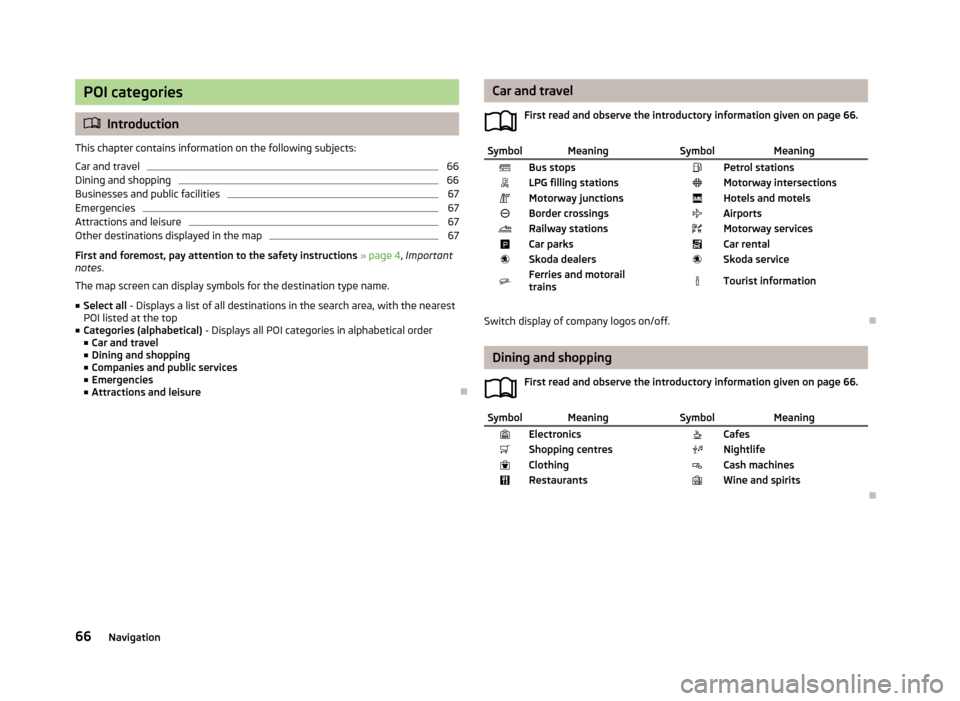
POI categories
Introduction
This chapter contains information on the following subjects:
Car and travel
66
Dining and shopping
66
Businesses and public facilities
67
Emergencies
67
Attractions and leisure
67
Other destinations displayed in the map
67
First and foremost, pay attention to the safety instructions » page 4 , Important
notes .
The map screen can display symbols for the destination type name.
■ Select all - Displays a list of all destinations in the search area, with the nearest
POI listed at the top
■ Categories (alphabetical) - Displays all POI categories in alphabetical order
■ Car and travel
■ Dining and shopping
■ Companies and public services
■ Emergencies
■ Attractions and leisure
Car and travel
First read and observe the introductory information given on page 66.SymbolMeaning SymbolMeaningBus stops Petrol stationsLPG filling stations Motorway intersectionsMotorway junctions Hotels and motelsBorder crossings AirportsRailway stations Motorway servicesCar parks Car rentalSkoda dealers Skoda serviceFerries and motorail
trains Tourist information
Switch display of company logos on/off.
Dining and shopping
First read and observe the introductory information given on page 66.
SymbolMeaning SymbolMeaningElectronics CafesShopping centres NightlifeClothing Cash machinesRestaurants Wine and spirits
66Navigation